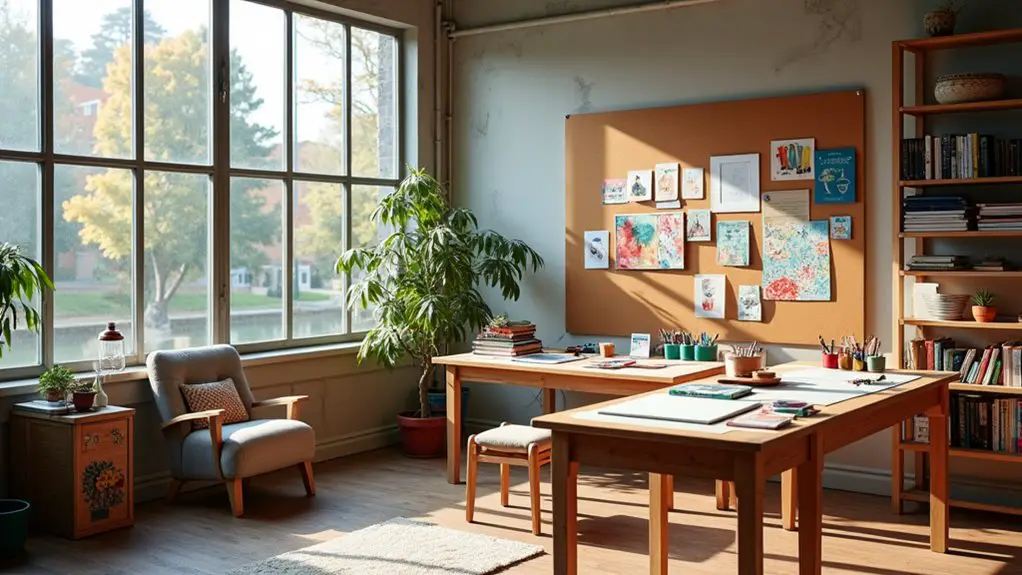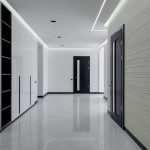To design a creative studio that truly inspires, start by evaluating your unique needs and workflow preferences. Choose a location that suits you, ensuring good access and a vibe you love. Maximize natural light with strategically placed windows and reflective surfaces. Select a color palette that energizes or calms your space. Incorporate flexible workspaces and personal touches that motivate you. Finally, maintain an organized area to boost creativity. Keep exploring for more tips to enhance your studio!
Table of Contents
Key Takeaways
- Assess ergonomic needs by selecting adjustable furniture and ensuring adequate lighting to enhance comfort and productivity.
- Choose a location that balances accessibility, noise levels, and natural light to foster creativity and inspiration.
- Create a cohesive color palette that reflects the desired mood and incorporates personal artwork and mementos for motivation.
- Design flexible workspaces with multi-functional furniture and open layouts to encourage collaboration and accommodate various project needs.
- Integrate technology and display solutions like shelves and pegboards to organize tools visually and showcase artistic work effectively.
Assessing Your Creative Needs
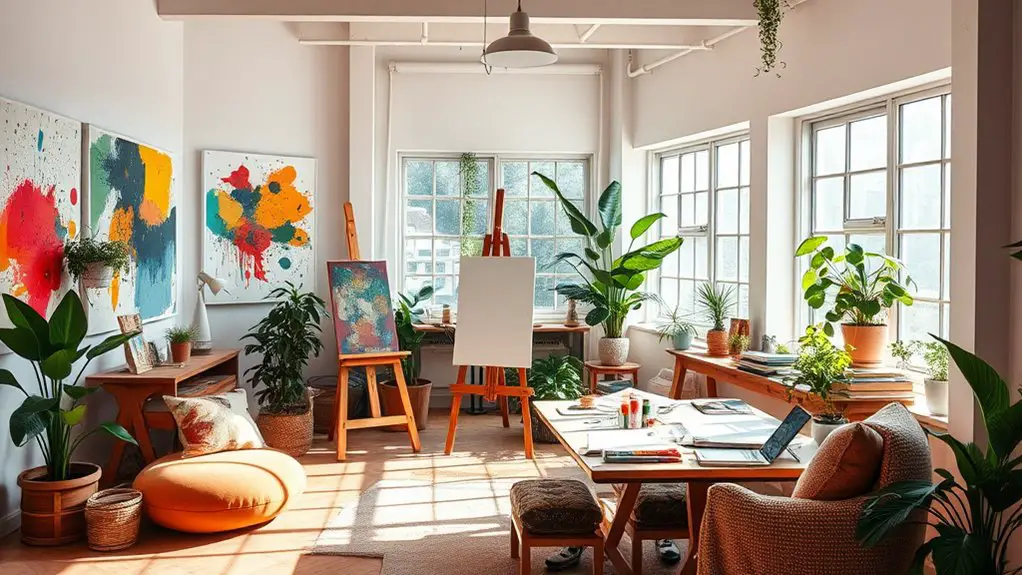
How do you envision your creative process? Understanding your creative needs is essential for designing a studio that fuels your inspiration.
Start by identifying the materials and tools you use most. Do you need ample space for painting, sculpting, or digital work?
Consider your workflow—do you prefer a structured environment or a more flexible setup? Think about the type of lighting that enhances your creativity. Natural light might energize you, while controlled lighting can help focus your work.
Also, reflect on comfort; an ergonomic chair or a standing desk can greatly impact your productivity.
Choosing the Right Location
Where you choose to set up your creative studio can greatly impact your artistic flow.
Start by considering your surroundings—do you prefer a bustling urban environment or a more tranquil, rural setting?
Think about accessibility; you'll want a location that's easy to reach, whether you're commuting or welcoming clients.
Also, assess the vibe of the area; a neighborhood filled with other artists can inspire collaboration and creativity.
Assessing the area's vibe can spark collaboration and amplify your creative energy, especially in artist-rich neighborhoods.
Don't forget about noise levels; a quieter space might help you concentrate better.
Finally, consider the size and layout of your studio—ensure it's flexible enough to accommodate your work style and equipment.
Ultimately, your location should nurture your creativity and make you feel inspired every time you step inside.
Maximizing Natural Light
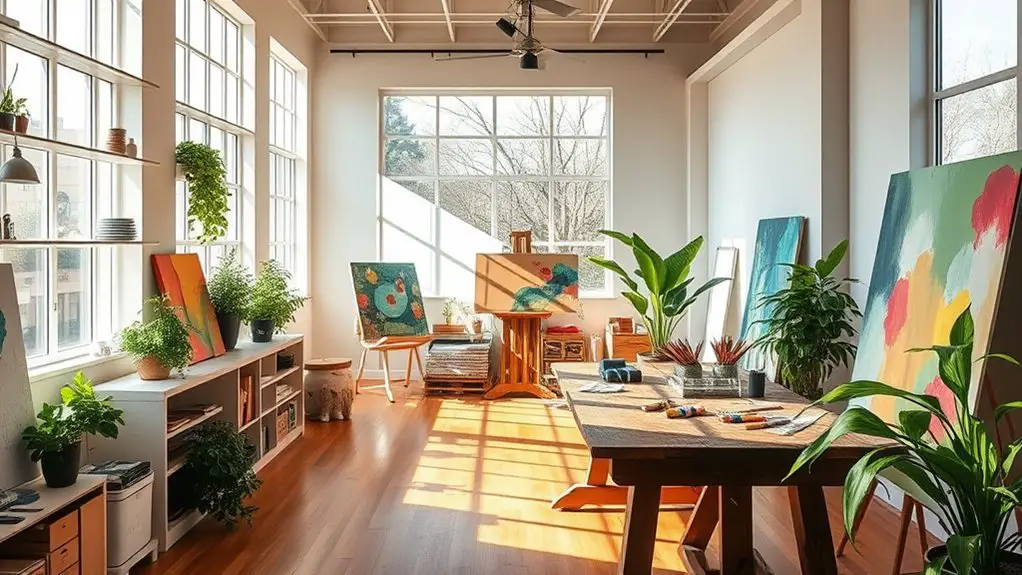
Maximizing natural light in your studio can transform your creative space and enhance your work.
By strategically placing windows, using reflective surfaces, and incorporating adjustable lighting options, you can create an inviting environment.
Let's explore how these elements can work together to brighten your studio.
Window Placement Strategies
Natural light can transform a creative studio, making it feel more vibrant and inspiring. To maximize this effect, consider your window placement carefully.
Position windows to capture the most sunlight throughout the day, ideally on the south or west sides of your studio. This orientation lets you enjoy consistent light, especially during afternoons.
Use larger windows or even skylights to flood the space with natural light, enhancing your creative energy. Avoid placing windows directly opposite each other, as this can create glare and uneven lighting.
Instead, think about using window treatments that diffuse light without blocking it entirely. By strategically placing your windows, you'll create a warm, inviting atmosphere that fuels your creativity and productivity.
Reflective Surfaces Utilization
In a creative studio, incorporating reflective surfaces can greatly amplify the amount of natural light that fills the space.
You can use mirrors, glossy paint, or metallic accents to bounce light around, creating a brighter environment that inspires creativity. Position mirrors opposite windows to maximize their effectiveness, allowing sunlight to scatter throughout the room.
Choose furniture with glass or chrome finishes to enhance this effect, and consider using light-colored walls to further reflect light.
Additionally, open shelving made from reflective materials can contribute to a light, airy feel.
Adjustable Lighting Options
While you want to make the most of the daylight streaming into your studio, having adjustable lighting options is equally important for those times when the sun isn't shining.
Proper lighting can enhance your creativity and focus. Here are some ideas to contemplate:
- Dimmer Switches: Install dimmer switches to control brightness based on your mood or task.
- Task Lighting: Use adjustable desk lamps for focused work, allowing you to direct light where needed.
- Color Temperature: Choose bulbs that mimic natural light, ranging from warm to cool, to match your creative needs.
- Smart Lighting: Reflect on smart bulbs that can change brightness and color with your smartphone, giving you flexibility.
With these options, you can create an adaptable environment that inspires your artistic process.
Selecting a Color Palette
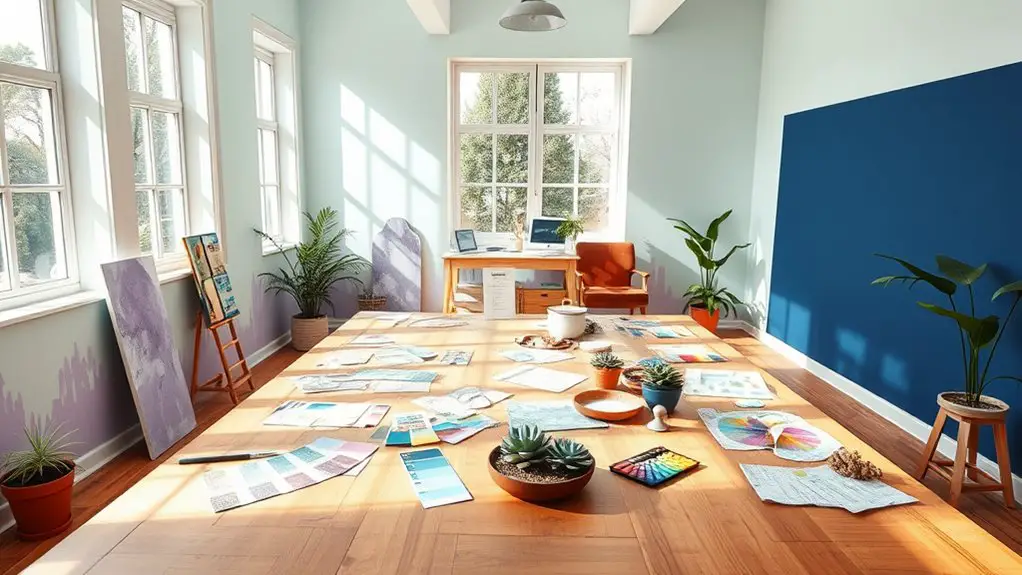
How do you choose the right color palette for your creative studio? Start by considering the mood you want to create. Do you want a calm, inspiring space or something more energetic?
Look at color theory basics; warm colors can stimulate creativity, while cool colors often promote focus. Next, gather inspiration from existing art, nature, or even objects around your home.
Use tools like color swatches or digital apps to experiment with combinations. Remember, balance is key; too many colors can overwhelm. Aim for a cohesive palette with a few dominant hues and complementary accents.
Finally, test your chosen colors in your space—observe how they change with lighting throughout the day. This will help guarantee your studio feels just right.
Incorporating Flexible Workspaces
When designing your creative studio, think about how flexible workspaces can enhance productivity.
Multi-functional furniture and an open layout can adapt to various projects and activities, giving you the freedom to create without constraints.
Multi-functional Furniture Solutions
As you design a creative studio, incorporating multi-functional furniture solutions can transform your workspace into a versatile environment that adapts to your needs.
These pieces not only save space but also enhance functionality, allowing you to switch between tasks seamlessly.
Consider these options:
- Convertible desks – Adjustable heights let you work sitting or standing.
- Storage ottomans – Serve as seating while keeping art supplies organized.
- Foldable tables – Easily expand your workspace for collaborative projects.
- Murphy beds – Create a guest area without sacrificing valuable floor space.
Open Layout Design Choices
To create an inspiring studio, prioritize an open layout that encourages collaboration and creativity. Flexible workspaces allow for adaptability, letting you adjust the environment to suit various projects. Consider incorporating distinct zones for different activities, while maintaining an airy flow.
Here's a quick breakdown of open layout design choices:
| Design Element | Benefits |
|---|---|
| Modular Furniture | Easily reconfigurable |
| Collaborative Areas | Promotes teamwork |
| Natural Lighting | Enhances mood and focus |
| Breakout Spaces | Offers relaxation options |
| Storage Solutions | Keeps the space organized |
Organizing Tools and Supplies
While you might be tempted to let your tools and supplies sprawl across your workspace, an organized studio can greatly enhance your creativity and productivity.
An organized studio boosts creativity and productivity, making it essential to keep your workspace tidy and efficient.
Start by categorizing your materials. Here's how to get organized:
- Sort: Group similar items together, like brushes, paints, and papers.
- Store: Use clear bins or drawers to keep supplies easily accessible. Label each container for quick identification.
- Display: Consider using wall-mounted shelves or pegboards. This not only saves space but keeps your essentials visible.
- Maintain: Regularly reassess your organization. Dedicate time weekly to tidy up and guarantee everything's in its place.
Creating Inspiring Display Areas
An organized workspace sets the stage for creativity, but it's the display areas that truly inspire. To create a enchanting environment, showcase your favorite art pieces, tools, and designs prominently. Consider using shelves, pegboards, or glass cases to elevate your work and spark motivation.
Here's a simple table to help you visualize display ideas:
| Display Type | Purpose | Tips |
|---|---|---|
| Shelves | Showcasing finished work | Use varying heights |
| Pegboards | Organizing tools visually | Color-code for easy access |
| Glass Cases | Protecting delicate items | Highlight special pieces |
| Wall Art | Infusing personal style | Mix mediums for interest |
Integrating Technology and Equipment
Integrating technology and equipment into your creative studio can greatly enhance productivity and inspiration. By incorporating the right tools, you can streamline your workflow and spark new ideas.
Incorporating the right technology in your studio can boost creativity and streamline your workflow for greater inspiration.
Here are four essential items to contemplate:
- High-Quality Computer: Invest in a powerful computer that can handle graphic design software and large files efficiently.
- Digital Drawing Tablet: Use a drawing tablet for precision in your artwork and to easily transfer sketches into digital formats.
- 3D Printer: A 3D printer allows you to create prototypes and tangible models of your designs, expanding your creative possibilities.
- Smart Lighting: Install adjustable, smart lighting to set the mood and enhance your focus during different projects.
Embrace these tools to elevate your creative practice!
Adding Personal Touches
Adding personal touches to your creative studio can transform it into a space that truly reflects your individuality and inspires your work.
Start by incorporating artwork that resonates with you—whether it's your own creations or pieces from other artists. Use colors that ignite your creativity; paint walls or add accessories that evoke positive emotions.
Display mementos from your travels or experiences that spark inspiration. Consider a dedicated area for your favorite books or magazines, showcasing your influences.
Personalize your workspace with items that bring you joy, like plants or meaningful quotes.
Ensuring Comfortable Ergonomics
While creating a space that inspires creativity, it's important to guarantee comfortable ergonomics to support your artistic endeavors.
By prioritizing ergonomics, you can enhance your productivity and comfort, allowing your creativity to flourish.
Here are four key elements to examine:
- Chair Selection: Choose an adjustable chair that supports your lower back and promotes good posture.
- Desk Height: Opt for a desk at a height that allows your elbows to rest comfortably at 90 degrees.
- Lighting: Confirm adequate lighting to reduce eye strain, using both natural light and adjustable lamps.
- Tool Accessibility: Organize your tools within easy reach, so you can work efficiently without unnecessary stretching or straining.
Incorporating these elements will make your creative studio a more enjoyable place to work.
Establishing a Zone for Collaboration
Creating a collaborative zone in your studio is essential for sparking creativity among artists and designers.
An open layout design encourages interaction, while shared resource areas make it easy to access tools and materials.
Hosting regular brainstorming sessions can further enhance collaboration and generate innovative ideas.
Open Layout Design
Open layout design fosters an environment where collaboration thrives, allowing artists and designers to exchange ideas freely. In this setup, you can encourage creativity and innovation.
Here are four key benefits of an open layout:
- Enhanced Communication: Without walls, conversations flow easily, sparking spontaneous brainstorming sessions.
- Increased Flexibility: You can rearrange furniture and stations to adapt to different projects or group sizes.
- Shared Inspiration: Being in close proximity to others' work can inspire new perspectives and techniques.
- Community Building: An open space fosters a sense of belonging, making it easier to build relationships and collaborate effectively.
Shared Resource Areas
Shared resource areas serve as dynamic hubs where collaboration can flourish among artists and designers. By creating dedicated spaces for shared tools and materials, you encourage interaction and innovation.
Think about incorporating features like communal worktables, storage for supplies, and equipment that everyone can access. Consider adding a library of reference materials and inspirational resources to spark creativity.
Make sure the area is comfortable and inviting, with good lighting and seating options that promote discussion. This setting not only fosters teamwork but also helps build a sense of community among members.
When artists and designers can easily share resources, they're more likely to collaborate, share ideas, and push each other's creative boundaries.
Creative Brainstorming Sessions
Building on the collaborative spirit fostered in shared resource areas, establishing dedicated zones for creative brainstorming sessions can further enhance the innovative process.
These spaces should be designed to inspire and engage. Here are four key elements to take into account when creating your brainstorming zone:
- Flexible Seating: Use movable chairs and tables to adapt to different group sizes and dynamics.
- Visual Aids: Incorporate whiteboards or pinboards to capture ideas and encourage free thought.
- Comfortable Atmosphere: Guarantee good lighting and cozy furnishings to make participants feel relaxed and open-minded.
- Technology Access: Provide tools like projectors or smartboards for seamless idea sharing.
Maintaining a Clutter-Free Environment
While creating an inspiring space for creativity is essential, maintaining a clutter-free environment is equally crucial for artists and designers. A tidy workspace enhances focus and boosts productivity.
Start by regularly decluttering your studio—remove items you don't use frequently. Invest in storage solutions like shelves, bins, or drawers to organize tools and materials efficiently.
Regularly declutter your studio and invest in efficient storage solutions to keep your creative space organized and inspiring.
Keep your work surface clear to allow for spontaneous creativity. Designate specific areas for different activities, such as sketching or painting, which can help minimize mess.
Additionally, develop a daily routine to tidy up at the end of each session. By prioritizing cleanliness, you'll foster a more inviting and stimulating atmosphere, allowing your creativity to flourish without unnecessary distractions or chaos.
Frequently Asked Questions
What Budget Should I Allocate for Designing a Creative Studio?
When determining your budget, consider essential costs like space, equipment, and materials. It's wise to allocate about 20-30% for unexpected expenses, ensuring you've enough flexibility to adapt as your creative needs evolve.
How Can I Soundproof My Studio for Better Concentration?
To soundproof your studio, you can use acoustic panels, heavy curtains, and rugs. Seal gaps in windows and doors, and consider adding a thick door. These steps'll help minimize noise and enhance your focus.
What Should I Consider for Studio Ventilation?
When considering studio ventilation, you need to guarantee proper airflow. Think about natural ventilation options, like windows, or mechanical systems. Don't forget to balance air quality with temperature control for a comfortable working environment.
How Do I Ensure My Workspace Remains Safe for All Activities?
To guarantee your workspace stays safe, you should regularly inspect equipment, maintain clean surfaces, keep emergency exits clear, and educate everyone on safety protocols. It's essential to foster a culture of awareness and responsibility.
Can I Incorporate Outdoor Elements Into My Studio Design?
Absolutely, you can incorporate outdoor elements into your studio design! Consider adding large windows for natural light, plants for a fresh vibe, or even an outdoor workspace to inspire creativity and enhance your overall environment.
